Head of RIG: Pascal Madeleine, Professor (PM)
Download leaflet (PDF)
Objective
Our main activities aim at optimizing performance in sports and at work, to prevent musculoskeletal overload and injury and to optimize rehabilitation after injury. The research areas cover humanities, social & natural sciences.
The research group is an affiliated institution of the European College of Sport Science.
Research Area
The research is focused on two axes:
- Research within humanities & social sciences focusing on recognized cultures in sport clubs, transitional changes for talented athletes as well as body and mind connections in physical learning activities.
- Research within natural sciences contributing to the basic understanding of neuromuscular, physiological and biomechanical adaptations to physical activity.
A special focus lies on the development and application of research methods for innovative research in sports, exercise physiology, biomechanics & ergonomics. The goal is to apply and develop basic knowledge to enhance athletes/workers motor skills for improving performance and preventing injuries. An important part of this effort is dedicated to improvement of training modalities and equipment in parallel with the technological development.
The Physical Activity and Human Performance group consists of specialists from Biomechanics, Coaching, Engineering, Ergonomics, Physiology, Physiotherapy and, Sport Sciences. The interdisciplinary character of the group enables us to holistically approach applied as well as fundamental research questions.
Fundamental Areas
- Control of movement, role of afferent feedback in movement generation and balance control.
- Development of new models to investigate biological adaptation to loading and training.
- Novel concepts of linking physiological and mechanical responses
-
Cultures, learning and talent development in relation to sports and physical activities
Application
- Optimization of performance
- Creativity and talent development in sport
- Work-related musculoskeletal pain
- Risk factors for sports injury
- Training programs for injury prevention
- Cultures in sports
- Short and long term tissue reactions to interventions and training
- Clinical gait analysis
- Work-place and tools assessments and improvements in their design
Teaching and Training
Educational Programs
- Sports Science
- Biomedical Engineering and Informatics, bachelor and master (specialization in medical systems and biomechanics)
- Clinical Science and Technology
- Product Design and Psychology
- International doctoral School in Biomedical Science and Engineering
- Post doctoral opportunities
Topics
- Sport science
- Exercise physiology
- Measurement techniques
- Man-machine interaction
- Biomechanics
- Data processing
- Musculo-skeletal modelling
- Ergonomics
Innovation
The group collaborates with a number of private companies, e.g. Active Sports-wear, Alectia, Anybody, Brooks, DJO Nordic, DSB, Dansk Boldspil Union, Dansk Håndbold Forbund, Ecco, Ergomat, Footbalance, Grontmij | Carl Bro A/S, HedeDanmark, Medicovi, Meyland-Smith, Newline, Ortopædkirurgisk speciallægepraksis v. Søren Kaalund, Sahva, SAS, Scaniro, Sports Pharma.
Fundings
The research are/have been supported by Anti-Doping Danmark, Arbejdsmiljøsforskningsfondet, Danish Agency for Science, Danish Council for Independent Research | Technology and Production Sciences, Danish Rector’s Conference, Det Obelske Familiefond, Gigtforeningen, Innovations Fonden, Ministry of Culture Committee on Sports Research, Technology and Innovation, Spar Nord, Velux Fonden, Gigtforeningen, Marie Curie Research Training Network, European Union..
Projects
- ALFA Aldring og fysisk betonet arbejde
- An individualised model of the human ankle joint – development and application to high risk movements
- ErgoVar
- Individualized Osteoarthritis interventions (IOI)
- International Training Network KNEEMO
- Work, aging, mental fatigue and eye movement dynamics (WAME)
Senior Members
Professors and Associate Professors:
- Oline Bjørkelund
- Ernst Albin Hansen, Motor Behaviour and Performance Laboratory
- Jesper Franch, Applied Exercise Physiology and Metabolism Laboratory
- Uwe Kersting, Movement Dynamics and Sport Technology Laboratory
- Mathias V Kristiansen, Motor Behaviour and Performance Laboratory
- Kenneth K Larsen
- Ryan G Larsen, Applied Exercise Physiology and Metabolism Laboratory
- Pascal Madeleine (RIG head), Ergonomics and Work-related Disorders Laboratory
- Niels N Rossing
- Afshin Samani, Ergonomics and Work-related Disorders Laboratory
- Lotte S Skrubbeltrang
- Jens Frederik Thomsen
- Michael Voigt, Biomechanics and Motor Control Laboratory
- Mark de Zee, Musculoskeletal Modeling Laboratory
- Stefanos Volianitis
Afiliated Researchers
- Lars L Andersen, (National Research Centre for the Working Environment)
- Uffe Læssøe, (University College North Jutland)
- Nicolas Vuillerme (Université Grenoble Alpes)
As well as approx. 20 PhD students
